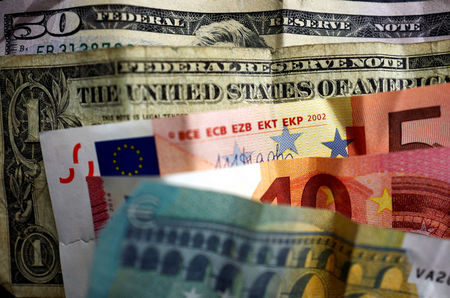Dollar gains on tariffs fears; euro looks to ECB meeting
2025.01.27 05:21

Investing.com – The US dollar slipped lower Monday, rebounding after recent losses as attention returned to the potential for trade tariffs from the Trump administration at the start of a week in which the Federal Reserve holds a policy-setting meeting.
At 04:35 ET (09:35 GMT), the Dollar Index, which tracks the greenback against a basket of six other currencies, traded 0.1% higher to 107.310, down more than 1% this week.
Tariff threat helps dollar
The dollar last week suffered its weakest week since November 2023 as Donald Trump appeared to rein in the threat of trade tariffs, prompting traders to reduce the risk premium embedded into the currencies of key trading partners.
However, these worries resurfaced as the US successfully used the threat of import tariffs against Colombia to secure its policy aim of returning illegal immigrants.
“The use of tariffs as a policy lever now looks well understood by the market and perhaps will be worth decreasing marginal volatility,” said analysts at ING, in a note. “That said, the FX market is still operating off a potential 1 February deadline for tariffs against Mexico, Canada and China – and that may prevent the dollar from correcting too much further this week.”
The prospect of high tariffs on goods from countries including China, Canada, Mexico, and the eurozone, has stoked concerns about a renewed bout of inflation, boosting the US dollar in recent months.
The concludes its latest two-day policy-setting meeting on Wednesday, and is widely expected to keep interest rates unchanged.
Euro lower ahead of ECB meeting
In Europe, gained 0.1% to 1.0489 after German business morale unexpectedly improved in January thanks to a more positive assessment of the current economic situation, a survey showed on Monday.
The Ifo institute said its increased to 85.1 in January from 84.7 in the previous month, while the current conditions index rose to 86.1 in January from 85.1 in December.
This added to last week’s improved eurozone activity data for January, suggesting that the eurozone economy is slowly improving.
However, the is still widely expected to cut interest rates once more when it next meets.
Traders are watching for further clues from ECB chief that could move the needle for the three further cuts they expect this year after Thursday’s move.
“Expect EUR/USD probably to be contained in a 1.0400-1.0500 range for the near term, with the next catalysts for a move being the FOMC and ECB meetings on Wednesday and Thursday respectively,” ING added.
traded 0.1% lower to 1.2460, with sterling showing weakness ahead of the next meeting in early February.
“We think there is a good case for GBP/USD to be trading 1.19/20 later this year as the Bank of England picks up the pace of its easing cycle and the chancellor may have to come back to the table with more fiscal tightening later this year,” ING added.
Yuan slips after weak Chinese PMI data
In Asia, traded 0.6% lower to 154.76, with the yen benefiting from the Bank of Japan increasing interest rates last week.
The central bank also indicated that it plans additional rate hikes if its economic outlook aligns with expectations in the coming months.
traded 0.2% higher to 7.2603, after China’s unexpectedly contracted in January, as recent stimulus measures from Beijing provided only brief support to local businesses.
Meanwhile, growth in the also slowed significantly during the month, with local businesses facing uncertainty due to the potential for higher US trade tariffs.








